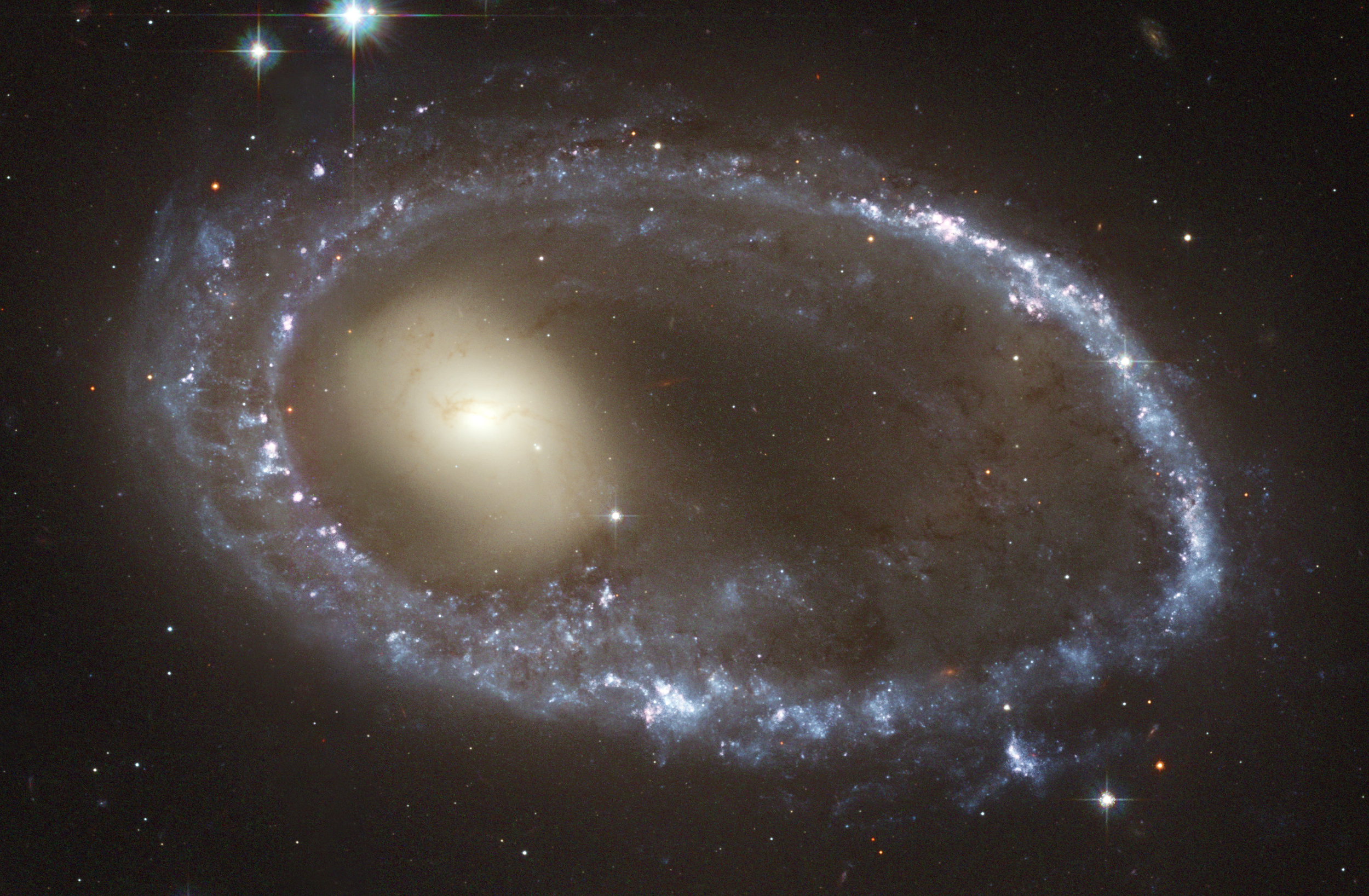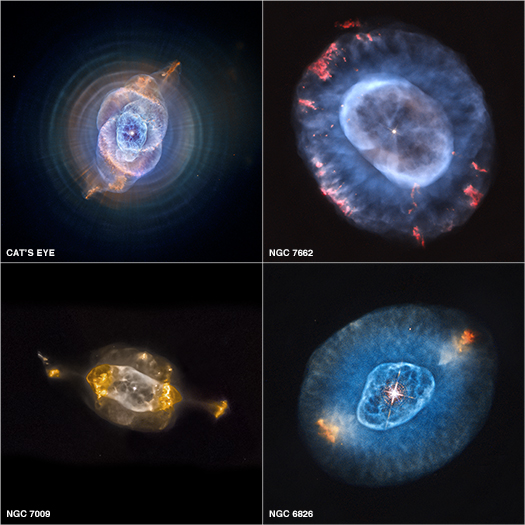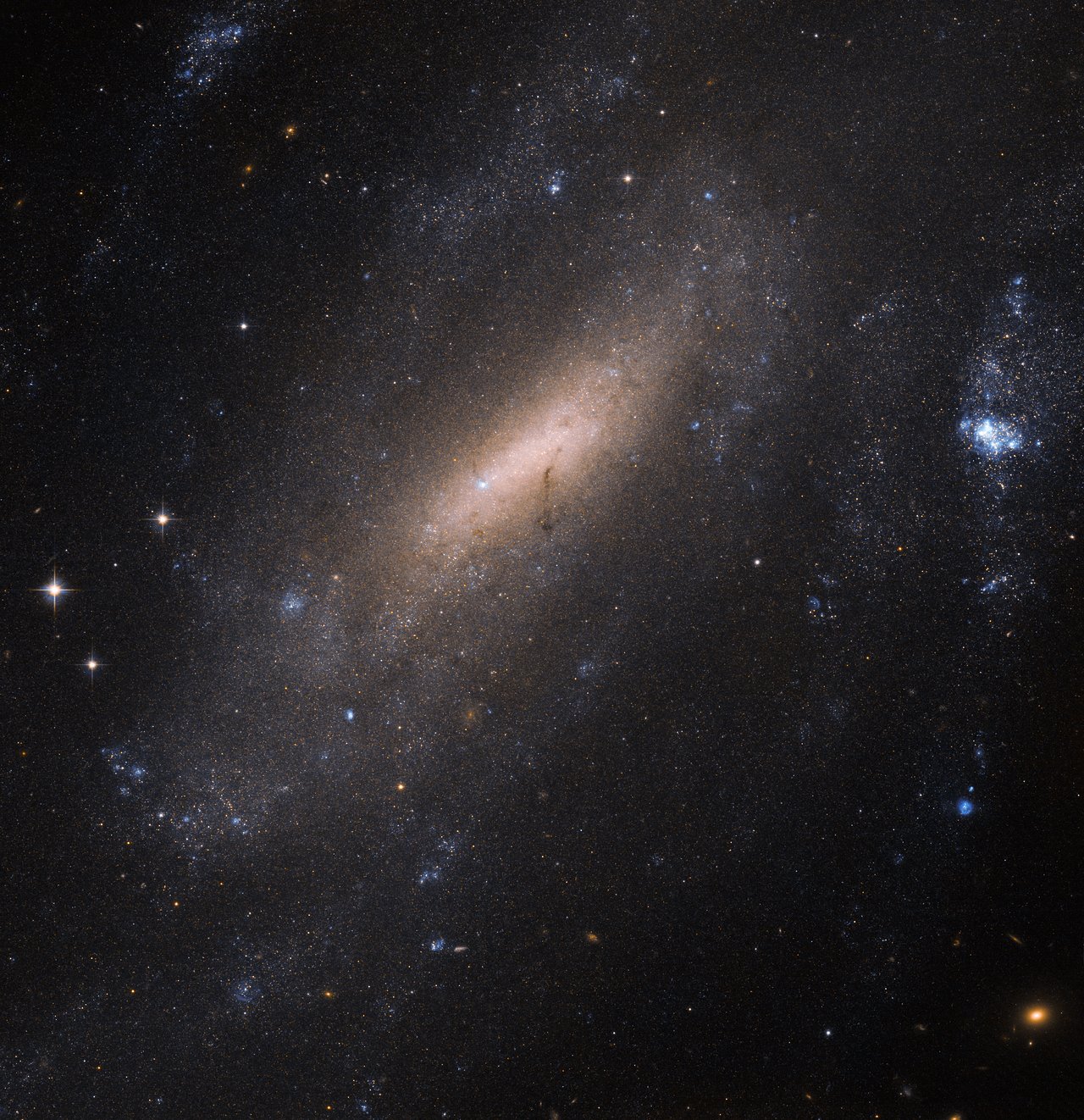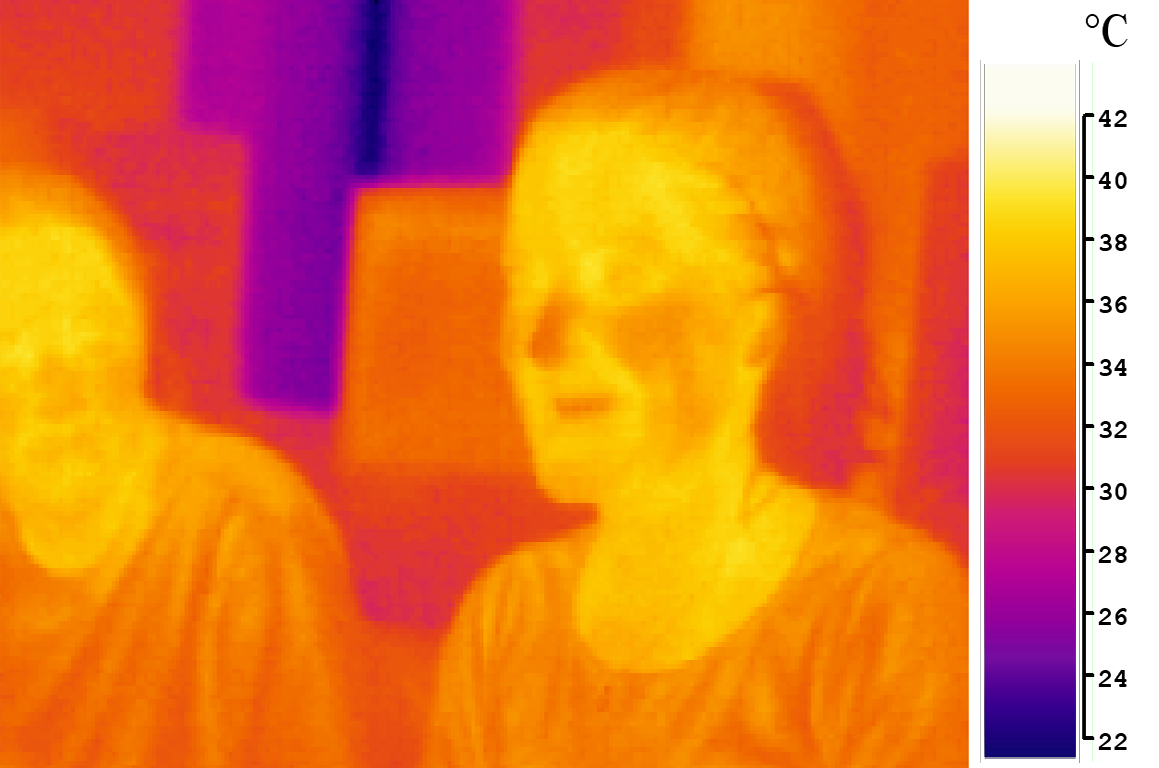|
NGC 2683
NGC 2683 is a field spiral galaxy in the northern constellation of Lynx. It was nicknamed the "UFO Galaxy" by the Astronaut Memorial Planetarium and Observatory. It was discovered by the astronomer William Herschel on February 5, 1788. It is viewed nearly edge-on from Earth's location in space and is located about 30 million light-years away, although previous estimates also give distances between 16 and 25 million light-years. NGC 2683 is receding from Earth at , and from the Galactic Center at . Visibility The reddened light from the center of the galaxy appears yellowish due to the intervening gas and dust located within the outer arms of NGC 2683. Its apparent magnitude is 10.6 making it not visible to the human eye without the aid of a small telescope. Characteristics While usually considered an unbarred spiral galaxy, recent research suggests it may in fact be a barred spiral galaxy; its bar is hard to see due to its high inclination. Further support for the presence ... [...More Info...] [...Related Items...] OR: [Wikipedia] [Google] [Baidu] |
Hubble Space Telescope
The Hubble Space Telescope (often referred to as HST or Hubble) is a space telescope that was launched into low Earth orbit in 1990 and remains in operation. It was not the first space telescope, but it is one of the largest and most versatile, renowned both as a vital research tool and as a public relations boon for astronomy. The Hubble telescope is named after astronomer Edwin Hubble and is one of NASA's Great Observatories. The Space Telescope Science Institute (STScI) selects Hubble's targets and processes the resulting data, while the Goddard Space Flight Center (GSFC) controls the spacecraft. Hubble features a mirror, and its five main instruments observe in the ultraviolet, visible, and near-infrared regions of the electromagnetic spectrum. Hubble's orbit outside the distortion of Earth's atmosphere allows it to capture extremely high-resolution images with substantially lower background light than ground-based telescopes. It has recorded some of the most ... [...More Info...] [...Related Items...] OR: [Wikipedia] [Google] [Baidu] |
Unbarred Spiral Galaxy
An unbarred spiral galaxyAstronomy Pictures(accessed 18 April 2010) is a type of spiral galaxy without a central bar, or one that is not a barred spiral galaxy. It is designated with an SA in the galaxy morphological classification scheme. Barless spiral galaxies are one of three general types of spiral galaxies under the ''de Vaucouleurs system'' classification system, the other two being intermediate spiral galaxy and barred spiral galaxy. Under the ''Hubble tuning fork'', it is one of two general types of spiral galaxy, the other being barred spirals. Grades Unbarred lenticular galaxy An unbarred lenticular galaxy is a lenticular Lenticular is an adjective often relating to lenses. It may refer to: * A term used with two meanings in botany: see * Lenticular cloud, a lens-shaped cloud * Lenticular galaxy, a lens-shaped galaxy * Lenticular (geology), adjective describing a ... version of an unbarred spiral galaxy. They have the Hubble type of SA0. An example ... [...More Info...] [...Related Items...] OR: [Wikipedia] [Google] [Baidu] |
NGC Objects
The ''New General Catalogue of Nebulae and Clusters of Stars'' (abbreviated NGC) is an astronomical catalogue of deep-sky objects compiled by John Louis Emil Dreyer in 1888. The NGC contains 7,840 objects, including galaxies, star clusters and emission nebulae. Dreyer published two supplements to the NGC in 1895 and 1908, known as the ''Index Catalogues'' (abbreviated IC), describing a further 5,386 astronomical objects. Thousands of these objects are best known by their NGC or IC numbers, which remain in widespread use. The NGC expanded and consolidated the cataloguing work of William and Caroline Herschel, and John Herschel's '' General Catalogue of Nebulae and Clusters of Stars''. Objects south of the celestial equator are catalogued somewhat less thoroughly, but many were included based on observation by John Herschel or James Dunlop. The NGC contained multiple errors, but attempts to eliminate them were made by the ''Revised New General Catalogue'' (RNGC) by Jack W. ... [...More Info...] [...Related Items...] OR: [Wikipedia] [Google] [Baidu] |
Field Galaxies , about
A field galaxy is a galaxy that does not belong to a larger galaxy group or cluster and hence is gravitationally alone. Roughly 80% of all galaxies located within of the Milky Way are in groups or clusters of galaxies. Most low-surface-brightness galaxies are field galaxies."An Introduction to Galaxies and Cosmology", ''David J. Adams and others'' The median Hubble-type of field galaxies is Sb, a type of spiral galaxy. List of field galaxies A list of nearby relatively bright field galaxies within the Local Volume The Local Volume is a collection of more than 500 galaxies located in an area of the observable universe near us, within a spherical region with a radius of 11 megaparsecs from Earth or up to a radial velocity of redshift of z < 0.002 (550 km/s). ... Further reading * * * * * References < ...
|
Unbarred Spiral Galaxies
A barred spiral galaxy is a spiral galaxy with a central bar-shaped structure composed of stars. Bars are found in about two thirds of all spiral galaxies, and generally affect both the motions of stars and interstellar gas within spiral galaxies and can affect spiral arms as well. The Milky Way Galaxy, where the Solar System is located, is classified as a barred spiral galaxy. Edwin Hubble classified spiral galaxies of this type as "SB" (spiral, barred) in his Hubble sequence and arranged them into sub-categories based on how open the arms of the spiral are. SBa types feature tightly bound arms, while SBc types are at the other extreme and have loosely bound arms. SBb-type galaxies lie in between the two. SB0 is a barred lenticular galaxy. A new type, SBm, was subsequently created to describe somewhat irregular barred spirals, such as the Magellanic Clouds, which were once classified as irregular galaxies, but have since been found to contain barred spiral structures. Among o ... [...More Info...] [...Related Items...] OR: [Wikipedia] [Google] [Baidu] |
Dwarf Spheroidal Galaxies
A dwarf spheroidal galaxy (dSph) is a term in astronomy applied to small, low-luminosity galaxies with very little dust and an older stellar population. They are found in the Local Group as companions to the Milky Way and to systems that are companions to the Andromeda Galaxy (M31). While similar to dwarf elliptical galaxies in appearance and properties such as little to no gas or dust or recent star formation, they are approximately spheroidal in shape and generally have lower luminosity. Discovery Despite the radii of dSphs being much larger than those of globular clusters, they are much more difficult to find due to their low luminosities and surface brightnesses. Dwarf spheroidal galaxies have a large range of luminosities, and known dwarf spheroidal galaxies span several orders of magnitude of luminosity. Their luminosities are so low that Ursa Minor, Carina, and Draco, the known dwarf spheroidal galaxies with the lowest luminosities, have mass-to-light ratios (M/L) ... [...More Info...] [...Related Items...] OR: [Wikipedia] [Google] [Baidu] |
Dwarf Irregular Galaxies
An irregular galaxy is a galaxy that does not have a distinct regular shape, unlike a spiral or an elliptical galaxy. Irregular galaxies do not fall into any of the regular classes of the Hubble sequence, and they are often chaotic in appearance, with neither a nuclear bulge nor any trace of spiral arm structure. Collectively they are thought to make up about a quarter of all galaxies. Some irregular galaxies were once spiral or elliptical galaxies but were deformed by an uneven external gravitational force. Irregular galaxies may contain abundant amounts of gas and dust. This is not necessarily true for dwarf irregulars. Irregular galaxies are commonly small, about one tenth the mass of the Milky Way galaxy. Due to their small sizes, they are prone to environmental effects like crashing with large galaxies and intergalactic clouds. Types There are three major types of irregular galaxies: * An Irr-I galaxy (Irr I) is an irregular galaxy that features some structure but not e ... [...More Info...] [...Related Items...] OR: [Wikipedia] [Google] [Baidu] |
Globular Cluster
A globular cluster is a spheroidal conglomeration of stars. Globular clusters are bound together by gravity, with a higher concentration of stars towards their centers. They can contain anywhere from tens of thousands to many millions of member stars. Their name is derived from Latin (small sphere). Globular clusters are occasionally known simply as "globulars". Although one globular cluster, Omega Centauri, was observed in antiquity and long thought to be a star, recognition of the clusters' true nature came with the advent of telescopes in the 17th century. In early telescopic observations globular clusters appeared as fuzzy blobs, leading French astronomer Charles Messier to include many of them in his catalog of astronomical objects that he thought could be mistaken for comets. Using larger telescopes, 18th-century astronomers recognized that globular clusters are groups of many individual stars. Early in the 20th century the distribution of globular clusters in the sk ... [...More Info...] [...Related Items...] OR: [Wikipedia] [Google] [Baidu] |
Star Formation
Star formation is the process by which dense regions within molecular clouds in interstellar space, sometimes referred to as "stellar nurseries" or "star-forming regions", collapse and form stars. As a branch of astronomy, star formation includes the study of the interstellar medium (ISM) and giant molecular clouds (GMC) as precursors to the star formation process, and the study of protostars and young stellar objects as its immediate products. It is closely related to planet formation, another branch of astronomy. Star formation theory, as well as accounting for the formation of a single star, must also account for the statistics of binary stars and the initial mass function. Most stars do not form in isolation but as part of a group of stars referred as star clusters or stellar associations. Stellar nurseries Interstellar clouds A spiral galaxy like the Milky Way contains stars, stellar remnants, and a diffuse interstellar medium (ISM) of gas and dust. The inte ... [...More Info...] [...Related Items...] OR: [Wikipedia] [Google] [Baidu] |
Infrared
Infrared (IR), sometimes called infrared light, is electromagnetic radiation (EMR) with wavelengths longer than those of visible light. It is therefore invisible to the human eye. IR is generally understood to encompass wavelengths from around 1 millimeter (300 GHz) to the nominal red edge of the visible spectrum, around 700 nanometers (430 THz). Longer IR wavelengths (30 μm-100 μm) are sometimes included as part of the terahertz radiation range. Almost all black-body radiation from objects near room temperature is at infrared wavelengths. As a form of electromagnetic radiation, IR propagates energy and momentum, exerts radiation pressure, and has properties corresponding to both those of a wave and of a particle, the photon. It was long known that fires emit invisible heat; in 1681 the pioneering experimenter Edme Mariotte showed that glass, though transparent to sunlight, obstructed radiant heat. In 1800 the astronomer Sir William Herschel ... [...More Info...] [...Related Items...] OR: [Wikipedia] [Google] [Baidu] |
Molecular Hydrogen
Hydrogen is the chemical element with the symbol H and atomic number 1. Hydrogen is the lightest element. At standard conditions hydrogen is a gas of diatomic molecules having the formula . It is colorless, odorless, tasteless, non-toxic, and highly combustible. Hydrogen is the most abundant chemical substance in the universe, constituting roughly 75% of all normal matter.However, most of the universe's mass is not in the form of baryons or chemical elements. See dark matter and dark energy. Stars such as the Sun are mainly composed of hydrogen in the plasma state. Most of the hydrogen on Earth exists in molecular forms such as water and organic compounds. For the most common isotope of hydrogen (symbol 1H) each atom has one proton, one electron, and no neutrons. In the early universe, the formation of protons, the nuclei of hydrogen, occurred during the first second after the Big Bang. The emergence of neutral hydrogen atoms throughout the universe occurred about 3 ... [...More Info...] [...Related Items...] OR: [Wikipedia] [Google] [Baidu] |
Neutral Hydrogen
The hydrogen line, 21 centimeter line, or H I line is the electromagnetic radiation spectral line that is created by a change in the energy state of neutral hydrogen atoms. This electromagnetic radiation has a precise frequency of , which is equivalent to the vacuum wavelength of in free space. This frequency falls below the microwave region of the electromagnetic spectrum, which begins at 3.0 GHz (10 cm wavelength), and it is observed frequently in radio astronomy because those radio waves can penetrate the large clouds of interstellar cosmic dust that are opaque to visible light. This line is also the theoretical basis of the hydrogen maser. The microwaves of the hydrogen line come from the atomic transition of an electron between the two hyperfine levels of the hydrogen 1 s ground state that have an energy difference of []. It is called the ''spin-flip transition''. The frequency, , of the quantum, quanta that are emitted by this transition between two ... [...More Info...] [...Related Items...] OR: [Wikipedia] [Google] [Baidu] |






